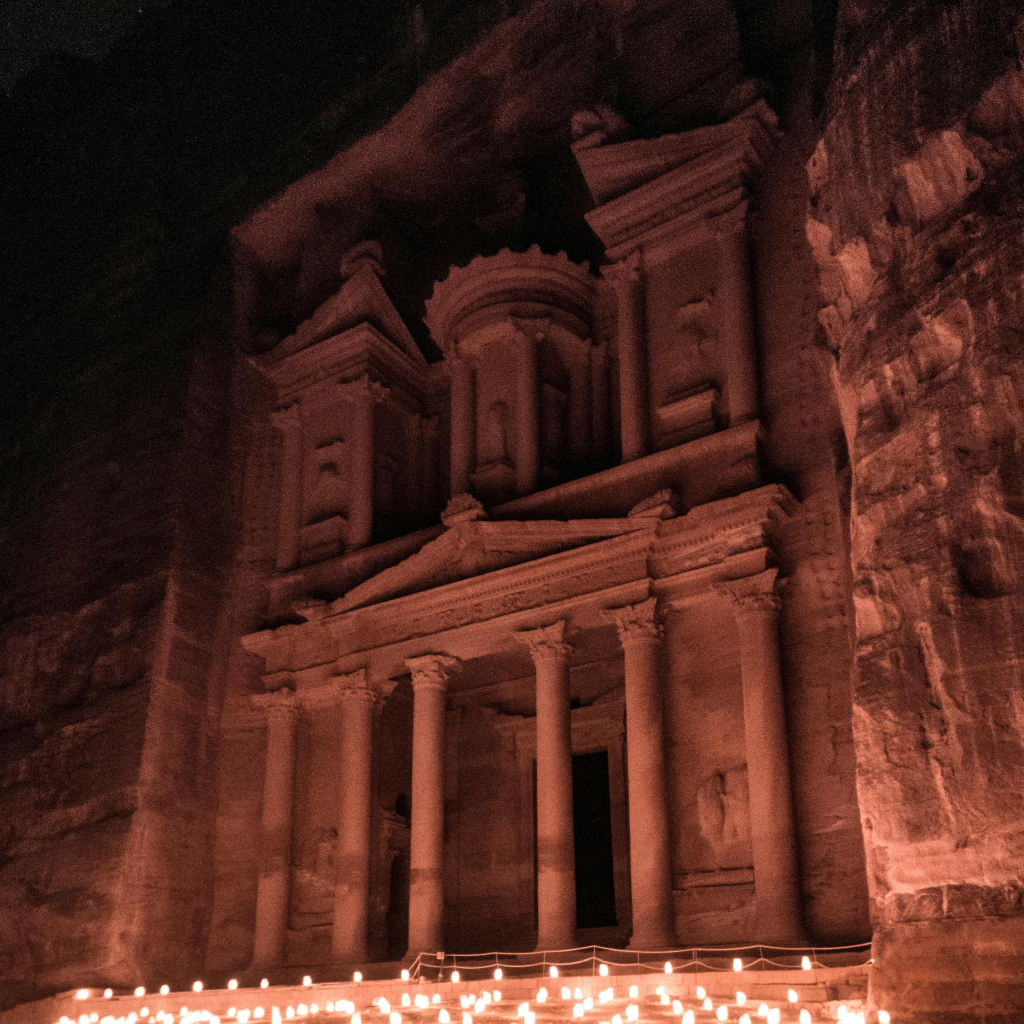Nestled in the rugged desert canyons of southern Jordan, an ancient city has captivated the imagination of travelers, historians, and archaeologists for centuries. Petra, often referred to as the “Rose-Red City” due to the color of the rock from which it is carved, stands as a testament to human ingenuity, artistry, and the enduring power of civilization. This UNESCO World Heritage site, recognized as one of the New Seven Wonders of the World, offers more than just a glimpse into the past—it provides a window into a fascinating civilization that thrived over 2,000 years ago, leaving an indelible mark on history.
The Rich Tapestry of Petra’s History
Origins and the Nabataean Kingdom
The story of Petra begins around 312 BC with the Nabataeans, an ancient Arab tribe renowned for their architectural prowess and innovative water management systems. The Nabataeans chose this location for their capital city with strategic brilliance. Petra’s position along vital trade routes connecting Arabia, Egypt, and the Levant with the Mediterranean world allowed the Nabataeans to grow immensely wealthy and powerful.
The Nabataeans were initially nomadic pastoralists who gradually settled and developed a sophisticated urban culture. They were skilled traders, facilitating the exchange of precious commodities such as frankincense, myrrh, and spices. Their control over the water supply in this arid region, coupled with their ability to charge tolls on passing caravans, further cemented their economic and political power.
The Golden Age of Petra
At its zenith, Petra was home to an estimated 20,000 inhabitants and served as the beating heart of the Nabataean Kingdom. The city flourished for several centuries, reaching its peak during the 1st century BC to the 1st century AD. During this period, Petra saw the construction of its most iconic monuments, including the Treasury and the Monastery.
The Nabataeans developed a unique culture that blended influences from surrounding civilizations. Their architecture shows clear Hellenistic influences, while their religious practices incorporated elements from Arab, Mesopotamian, and Greco-Roman traditions. This cultural fusion is evident in the art and architecture of Petra, making it a truly unique site in the ancient world.
Roman Annexation and Gradual Decline
The prosperity of Petra eventually attracted the attention of the expanding Roman Empire. In 106 AD, under Emperor Trajan, the Romans annexed the Nabataean Kingdom, incorporating it into the province of Arabia Petraea. While this marked the end of Nabataean independence, it did not immediately spell doom for the city.
Under Roman rule, Petra continued to thrive for a time. The Romans constructed new buildings, including a columnaded street and a public fountain, and expanded the city’s infrastructure. However, changing trade routes and the shift of the empire’s focus to other regions gradually diminished Petra’s importance.
A devastating earthquake in 363 AD caused significant damage to the city and its water management systems. This natural disaster, combined with the changing economic landscape, accelerated Petra’s decline. By the 7th century AD, with the rise of Islam and the further shift of trade routes, Petra had largely faded from prominence.
Rediscovery and Modern Recognition
For centuries, Petra lay forgotten by the Western world, known only to local Bedouin tribes. It wasn’t until 1812 that Swiss explorer Johann Ludwig Burckhardt, disguised as an Arab scholar, rediscovered the ancient city. Burckhardt’s accounts of the magnificent ruins sparked renewed interest in Petra among European scholars and travelers.
In the centuries since its rediscovery, Petra has captured the world’s imagination. It has been the subject of numerous archaeological expeditions, each uncovering new facets of Nabataean culture and history. In 1985, UNESCO recognized Petra as a World Heritage Site, and in 2007, it was named one of the New Seven Wonders of the World, cementing its place as one of the planet’s most extraordinary archaeological treasures.
Architectural Marvels: A Closer Look
Petra’s architecture is a stunning blend of Nabataean, Hellenistic, and Roman influences, carved into the vibrant sandstone cliffs. Let’s explore some of the most significant structures in more detail.
The Treasury (Al-Khazneh)
The Treasury, or Al-Khazneh in Arabic, is undoubtedly the most iconic structure in Petra. Standing at an impressive 40 meters high and intricately decorated with Corinthian columns, friezes, and figures, it is the first major monument visitors encounter as they emerge from the narrow Siq.
Despite its name, the Treasury was likely not used to store valuables. Instead, it probably served as a temple or a royal tomb. The structure’s façade is divided into two levels. The lower level features six columns and various sculptural decorations, including figures of the twins Castor and Pollux. The upper level is adorned with a central tholos (a circular temple) flanked by broken pediments.
The name “Treasury” comes from a local legend that an Egyptian Pharaoh hid his treasure here while pursuing the Israelites. In reality, the urn crowning the tholos is solid stone, but bullet marks from Bedouin tribes trying to release the supposed treasure can still be seen.
The preservation of the Treasury is remarkable, largely due to the protection offered by the narrow canyon in which it sits. This has shielded the façade from wind and rain, allowing us to marvel at its intricate details even after two millennia.
The Monastery (Ad-Deir)
Rivaling the Treasury in grandeur is the Monastery, known locally as Ad-Deir. Perched high in the hills of Petra, the Monastery requires visitors to climb over 800 rock-cut steps to reach it. However, the breathtaking view and the monument itself make the challenging ascent worthwhile.
The Monastery’s façade is truly colossal, measuring 50 meters wide and 45 meters high, surpassing even the Treasury in size. Like the Treasury, it features a bi-level design with columns, but with a simpler, more austere decoration that some argue is even more impressive in its grandeur.
Despite its name, the structure was likely not a monastery. It may have been used as a temple, possibly dedicated to the deified Nabataean King Obodas I. Later, during the Byzantine period, it may have been used as a church, which could explain its current name.
The interior of the Monastery consists of a single room with an altar against the rear wall. The vastness of this inner chamber, measuring 11.5 meters by 10 meters, is awe-inspiring.
The Royal Tombs
The Royal Tombs, carved into the face of Jebel al-Khubtha, represent some of the most impressive and well-preserved structures in Petra. Although we can’t be certain that they were all used for royalty, their grand scale and elaborate decoration suggest they were reserved for Petra’s elite.
- The Urn Tomb: This is the first and largest of the Royal Tombs. Its distinctive feature is the enormous urn that crowns the pediment. The tomb has a large courtyard in front and a colonnade on the lower level. In the 5th century AD, it was converted into a Byzantine church.
- The Silk Tomb: Named for the remarkable swirls of color in its rock face, the Silk Tomb showcases the natural beauty of Petra’s geology. While its façade is eroded, the vibrant streaks of yellow, red, and brown in the stone create a stunning visual effect.
- The Corinthian Tomb: This tomb bears a striking resemblance to the Treasury, albeit on a smaller scale. It features Corinthian columns and decorative urns, demonstrating the Hellenistic influences on Nabataean architecture.
- The Palace Tomb: The largest of the Royal Tombs, the Palace Tomb is an impressive structure that resembles a Roman palace façade. It features multiple stories and a wide frontage, with columns and pediments adorning its face.
The Street of Facades
As visitors move beyond the Treasury and into the outer Siq, they encounter the Street of Facades. This row of monumental Nabataean tombs carved into the southern cliff face offers a fascinating glimpse into the evolution of Nabataean funerary architecture.
The tombs here vary in size and decoration, with some featuring simple, unadorned entrances and others boasting more elaborate designs with columns, pediments, and crowsteps. This variety not only demonstrates the skill of Nabataean stonemasons but also provides insights into the social stratification of Nabataean society, with larger, more ornate tombs likely belonging to wealthier or more prominent individuals.
The Theater
Carved into the side of a mountain at the foot of the High Place of Sacrifice, Petra’s theater is a testament to the city’s adoption of Roman cultural elements. Built in the 1st century AD, it could seat between 5,000 to 8,000 spectators.
The theater’s design follows classical Roman architecture, with a semicircular auditorium, an orchestra, and a stage building. However, unlike typical Roman theaters built with cut blocks, this one was largely carved out of solid rock, showcasing the Nabataeans’ mastery of rock-cutting techniques.
The Colonnaded Street
The Colonnaded Street represents the main thoroughfare of ancient Petra. Constructed in the 2nd century AD during the period of Roman control, it stretched for about 800 meters through the city center.
The street was lined with columns, some of which still stand today, and would have been flanked by shops, public buildings, and luxury villas. At its southern end, it led to a monumental gate, while the northern end connected to the Temenos Gate, which marked the entrance to the sacred precinct of the Qasr al-Bint temple.
This grand avenue would have been a bustling center of commercial and social activity in Roman-era Petra, showcasing the city’s continued importance even after the end of Nabataean rule.
Engineering Marvels: The Lifeblood of Petra
While Petra’s monumental architecture often takes center stage, the city’s true genius lies in its sophisticated engineering, particularly its water management systems. These systems were not just conveniences; they were the lifeblood that allowed a city of thousands to thrive in an arid desert environment.
Water Conduit System
The Nabataeans developed an intricate and highly efficient water management system that was far ahead of its time. This system included a network of dams, cisterns, aqueducts, and pipes that channeled water from flash floods and springs into the city.
Key components of this system include:
- Dams: The Nabataeans constructed a series of dams in the surrounding wadis (valleys or ravines) to collect and control rainwater. These dams not only provided water but also protected the city from destructive flash floods.
- Cisterns: Hundreds of cisterns were carved into the rock throughout Petra to store water. These ranged from small household cisterns to enormous public reservoirs capable of holding thousands of cubic meters of water.
- Aqueducts: A network of aqueducts, some open and some closed, transported water from distant springs and dams into the city. The most impressive of these is the Siq aqueduct, which ran the length of the main entrance to the city.
- Pressure Pipes: The Nabataeans even developed a system of pressurized pipelines, using gravity and siphons to distribute water throughout the city, including to fountains and public baths.
This sophisticated system not only provided year-round water for the inhabitants and their animals but also supported extensive agriculture in the vicinity of Petra, allowing the city to sustain its large population.
The Siq
The Siq, the main entrance to Petra, is both a natural wonder and an engineering marvel. This narrow gorge, stretching for 1.2 kilometers, was formed by tectonic forces that split the mountain apart, then smoothed over millennia by water erosion.
The Nabataeans enhanced this natural feature in several ways:
- They smoothed the walls in places, carving niches for religious symbols and statues.
- They built a dam at the entrance to protect the city from flash floods.
- Most impressively, they constructed an aqueduct along one wall of the Siq to bring water into the city. Traces of this aqueduct, along with a parallel paved road, can still be seen today.
The Siq not only provided a dramatic entrance to the city but also served as a natural defense, as it could be easily guarded due to its narrow width.
Earthquake-Resistant Architecture
The Nabataeans developed building techniques that made their structures more resistant to the region’s frequent earthquakes. They used a technique called “float construction,” where buildings were not anchored directly to bedrock but sat on a layer of sand. This allowed the structures to “float” slightly during seismic activity, reducing damage.
Additionally, they used lead strips between stone blocks in some buildings, which acted as shock absorbers during earthquakes. These innovative techniques helped many of Petra’s monuments survive numerous seismic events over the centuries.
Cultural Significance: More Than Just Stone
Petra’s importance extends far beyond its architectural and engineering marvels. It represents a unique fusion of cultures and traditions, offering invaluable insights into ancient civilizations and their interactions.
Religious Significance
Petra was not just a political and economic center, but also a deeply religious one. The Nabataeans worshipped a pantheon of deities, with Dushara (the main male deity) and Al-‘Uzza (the main female deity) at its head. Many of the city’s monuments, including the High Place of Sacrifice and numerous temples, were dedicated to these gods.
The religious landscape of Petra evolved over time, incorporating elements from surrounding cultures. During the Roman period, many Nabataean deities were associated with their Roman counterparts. Later, with the advent of Christianity, some of Petra’s structures were converted into churches.
Artistic Legacy
Petra’s art and architecture represent a unique blend of Nabataean, Hellenistic, and Roman influences. The elaborate tomb facades, with their columns, pediments, and figurative sculptures, showcase this cultural fusion. Nabataean artisans were particularly skilled in stone carving, creating intricate designs and statues that have withstood the test of time.
Petra also provides valuable examples of ancient painting techniques. Although much has been lost to time, some structures still retain traces of their original painted decorations, offering glimpses into the vibrant colors that once adorned the city.
Trade and Cultural Exchange
As a major hub on ancient trade routes, Petra was a melting pot of cultures. Goods from as far as China, India, and the Mediterranean passed through the city, along with ideas, technologies, and artistic styles. This constant cultural exchange contributed to the unique character of Nabataean civilization and is reflected in the eclectic nature of Petra’s architecture and artifacts.
Modern Cultural Impact
Petra’s rediscovery in the 19th century sparked a renewed fascination with the ancient world in Western culture. It has since inspired countless works of art, literature, and film. Most famously, Petra’s Treasury served as the setting for the climactic scenes of the 1989 film “Indiana Jones and the Last Crusade,” introducing the ancient city to a global audience.
Today, Petra continues to captivate the world’s imagination. It serves as a powerful symbol of Jordan’s cultural heritage and plays a crucial role in the country’s tourism industry. The site has also become an important center for archaeological research, continually yielding new insights into ancient Nabataean civilization.
Visiting Petra Today: A Journey Through Time
Visiting Petra is more than just a tourist excursion; it’s a journey through time that allows you to walk in the footsteps of the Nabataeans, Romans, and countless others who have marveled at this city over the millennia.
Planning Your Visit
Petra is open year-round, but the best times to visit are during spring (March to May) and autumn (September to November) when the weather is milder. Summers can be extremely hot, while winters can be surprisingly cold and occasionally rainy.
A typical visit requires at least one full day, though two or three days allow for a more comprehensive exploration of the site. There are several ticket options available, including multi-day passes and night tours.
The Petra Experience
- The Siq: Your journey begins with a walk through the Siq, the narrow gorge that serves as the main entrance to Petra. This kilometer-long path, flanked by towering cliffs, builds anticipation for the wonders to come.
- The Treasury: As you exit the Siq, you’re greeted by the awe-inspiring view of the Treasury. This moment of reveal is often described as one of the most memorable experiences in travel.
- Street of Facades: Moving past the Treasury, you’ll encounter numerous tombs and dwellings carved into the sandstone cliffs.
- The Theater: Further along is the impressive Nabataean theater, capable of seating thousands of spectators
- Royal Tombs: The path then leads to the impressive Royal Tombs, carved into the western cliff face.
- Colonnaded Street: This ancient main street of Petra showcases the city’s Roman-era development.
- The Monastery: For those up for a challenging climb, the Monastery offers another spectacular façade and breathtaking views of the surrounding landscape.
- Other Sites: Depending on your time and energy, you can explore numerous other sites, including the Byzantine Church, the Temple of the Winged Lions, and the High Place of Sacrifice.
Practical Tips for Visitors
- Wear comfortable walking shoes and bring sun protection. The site involves a lot of walking, often on uneven terrain.
- Bring plenty of water. While there are vendors within the site, it’s best to be prepared.
- Consider hiring a guide. Their knowledge can greatly enhance your understanding and appreciation of the site.
- Respect the site. Petra is not just a tourist attraction but an invaluable piece of world heritage. Do not climb on monuments or remove any artifacts.
- Consider the Petra by Night experience. This special tour allows you to see the Siq and Treasury illuminated by thousands of candles.
- If possible, allow more than one day for your visit. Petra is vast, and there’s always more to discover.
Conservation Efforts and Challenges
As with many ancient sites, Petra faces significant conservation challenges. The very features that make it so spectacular – its rock-cut architecture and desert location – also make it vulnerable to erosion and damage.
Natural Threats
- Erosion: Wind and water erosion continue to wear away at the delicate sandstone structures.
- Flash Floods: Despite ancient flood control systems, sudden heavy rains can still pose a threat to the site.
- Earthquakes: The region is seismically active, posing an ongoing risk to the ancient structures.
Human-Induced Challenges
- Tourism Pressure: The sheer number of visitors can cause wear and tear on the ancient stones.
- Development: Balancing the needs of the local community with site preservation is an ongoing challenge.
- Improper Restoration: Past restoration efforts, while well-intentioned, sometimes used materials or techniques that caused additional damage.
Current Conservation Efforts
Numerous projects are underway to protect and preserve Petra:
- The Petra Archaeological Park operates under a comprehensive management plan to balance tourism, research, and conservation.
- International organizations like UNESCO and the World Monuments Fund are involved in various conservation projects.
- Advanced technologies, such as 3D scanning and modeling, are being used to monitor changes in the monuments over time.
- Efforts are being made to revive traditional Nabataean water management techniques to protect the site from flash floods.
- Visitor management strategies are being implemented to reduce the impact of tourism on the most vulnerable areas.
The Future of Petra
Despite the challenges, the future of Petra looks bright. Ongoing archaeological work continues to uncover new aspects of the ancient city, deepening our understanding of Nabataean civilization. Advanced conservation techniques promise to preserve the site for future generations, while sustainable tourism initiatives aim to balance visitor access with site protection.
Moreover, Petra’s significance extends beyond its physical structures. It stands as a powerful symbol of human achievement, cultural exchange, and the enduring legacy of ancient civilizations. As we continue to study and preserve Petra, we not only protect a unique historical site but also maintain a vital link to our shared human heritage.
Conclusion
Petra is more than just an archaeological site; it’s a journey through time, a testament to human ingenuity, and a wonder that continues to inspire awe in all who visit. From the moment you step into the Siq to the breathtaking reveal of the Treasury, from the monumental Royal Tombs to the awe-inspiring Monastery, Petra offers an unparalleled glimpse into an ancient civilization’s grandeur and ingenuity.
Whether you’re a history enthusiast, an adventure seeker, or simply someone in awe of human creativity, Petra promises an unforgettable experience. It challenges us to think beyond our time, to marvel at the achievements of the past, and to consider our own legacy for the future.
As you plan your next adventure, consider making Petra your destination. Walk in the footsteps of the Nabataeans, marvel at the rose-red cliffs, and immerse yourself in the magic of this ancient wonder. In doing so, you’ll not only witness one of the world’s most spectacular sites but also play a part in its ongoing story, helping to ensure that the Rose-Red City continues to inspire and amaze for generations to come.
We’d love to hear about your experiences or thoughts on Petra! Have you visited this ancient wonder? What was your favorite part? If you haven’t been yet, what aspect of Petra intrigues you the most? Share your stories and opinions in the comments below.
And if you found this article informative and inspiring, please share it with your friends and fellow travel enthusiasts. Let’s spread the wonder of Petra far and wide!






